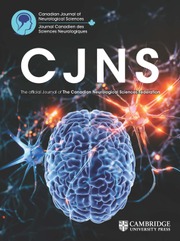No CrossRef data available.
Article contents
Reviewer Comment on Almekhlafi et al. “Adjunctive Intraarterial Thrombolysis after Thrombectomy in Large Vessel Occlusion Stroke: A Meta-Analysis of RCTs”
Published online by Cambridge University Press: 07 October 2025
Abstract
An abstract is not available for this content. As you have access to this content, full HTML content is provided on this page. A PDF of this content is also available in through the ‘Save PDF’ action button.
Information
- Type
- Reviewer Comment
- Information
- Creative Commons
- This is an Open Access article, distributed under the terms of the Creative Commons Attribution-NonCommercial-NoDerivatives licence (https://creativecommons.org/licenses/by-nc-nd/4.0/), which permits non-commercial re-use, distribution, and reproduction in any medium, provided that no alterations are made and the original article is properly cited. The written permission of Cambridge University Press must be obtained prior to any commercial use and/or adaptation of the article.
- Copyright
- © The Author(s), 2025. Published by Cambridge University Press on behalf of Canadian Neurological Sciences Federation
References
Goyal, M, Menon, BK, van Zwam, WH, et al. Endovascular thrombectomy after large-vessel ischaemic stroke: a meta-analysis of individual patient data from five randomised trials. Lancet. 2016;387(10029):1723–31. doi: 10.1016/S0140-6736(16)00163-X.CrossRefGoogle ScholarPubMed
Sperring, CP, Savage, WM, Argenziano, MG, et al. No-reflow post-recanalization in acute ischemic stroke: mechanisms, measurements, and molecular markers. Stroke. 2023;54(9):2472–80. doi: 10.1161/STROKEAHA.123.044240.CrossRefGoogle ScholarPubMed
Almekhlafi, MA, Park, H, Singh, N, et al. Adjunctive intraarterial thrombolysis after thrombectomy in large vessel occlusion stroke: a meta-analysis of RCTs. Can J Neurol Sci. 2025. doi: 10.1017/cjn.2025.10354.CrossRefGoogle Scholar
Hill, MD, Goyal, M, Demchuk, AM, et al. Efficacy and safety of nerinetide in acute ischaemic stroke in patients undergoing endovascular thrombectomy without previous thrombolysis (ESCAPE-NEXT): a multicentre, double-blind, randomised controlled trial. Lancet. 2025;405(10478):560–70. doi: 10.1016/S0140-6736(25)00194-1.CrossRefGoogle ScholarPubMed
Lapergue, B, Blanc, R, Costalat, V, et al. Effect of thrombectomy with combined contact aspiration and stent retriever vs stent retriever alone on revascularization in patients with acute ischemic stroke and large vessel occlusion: the ASTER2 randomized clinical trial. JAMA. 2021;326(12):1158–69. doi: 10.1001/jama.2021.13827.CrossRefGoogle ScholarPubMed
Turk, AS 3rd Siddiqui, A, Fifi, JT. Aspiration thrombectomy versus stent retriever thrombectomy as first-line approach for large vessel occlusion (COMPASS): a multicentre, randomised, open label, blinded outcome, non-inferiority trial. Lancet. 2019;393(10175):998–1008. doi: 10.1016/S0140-6736(19)30297-1.CrossRefGoogle ScholarPubMed


Endovascular thrombectomy (EVT) has transformed acute stroke care, yet approximately one-third of patients fail to achieve functional independence despite successful recanalization. Reference Goyal, Menon and van Zwam1 This clinical-angiographic mismatch, potentially attributed to microvascular dysfunction or ‘no-reflow phenomenon,’ has prompted investigation of adjunctive intra-arterial thrombolysis to enhance tissue-level reperfusion. Reference Sperring, Savage and Argenziano2
Almekhlafi and Park et al. present a timely meta-analysis of seven randomized controlled trials (2022–2025) evaluating intra-arterial thrombolysis following successful thrombectomy. Reference Almekhlafi, Park and Singh3 Their rigorous methodology, including their appropriate use of random-effects models for a limited number of trials and comprehensive subgroup analyses, provides valuable insights into this emerging therapeutic approach.
The analysis demonstrates that adjunctive intra-arterial thrombolysis significantly improves excellent functional outcomes (mRS 0–1: OR 1.45, 95% CI 1.19–1.76) and complete recovery (mRS 0: OR 1.34, 95% CI 1.09–1.64). Importantly, this benefit occurs without increased symptomatic hemorrhage risk (5.05% vs 4.49%, p = 0.53), addressing primary safety concerns. Even in the subset receiving intravenous thrombolysis before EVT, though limited to two trials, hemorrhagic complications remained comparable, suggesting the feasibility of the adjunctive thrombolytic therapy in selected patients.
The observed absolute risk difference of 9% for excellent functional outcome translates to a number needed to treat of approximately 11, which compares favorably to other adjunctive strategies in stroke, including neuroprotectants (largely negative trials) and mechanical aspiration devices (marginal benefits). Reference Hill, Goyal and Demchuk4–Reference Turk, Siddiqui and Fifi6 However, unlike these interventions, intra-arterial thrombolysis directly addresses a measurable pathophysiological target – persistent hypoperfusion despite epicardial recanalization – providing a stronger mechanistic rationale for selective implementation.
However, important limitations temper enthusiasm. Six of seven trials originated from China, where the prevalence of intracranial atherosclerosis differs substantially from that of patients from Canada or the USA, potentially limiting generalizability. The heterogeneity in thrombolytic agents and dosing protocols introduces uncertainty about optimal treatment parameters. Additionally, the paradoxical finding of benefit for excellent but not good functional outcomes (mRS 0–2) warrants further investigation.
Several ongoing trials will address these knowledge gaps. BRIDGE-TNK (NCT04733742), BRETIS-TNK II (NCT05657444), TECNO (NCT05499832) and the REACT trial within ACT-GLOBAL (NCT06352632) will provide crucial data on patient selection, optimal dosing and generalizability across diverse populations. These studies will likely establish whether adjunctive intra-arterial thrombolysis becomes standard care for selected patients.
Until definitive evidence emerges, this meta-analysis supports cautious implementation of adjunctive intra-arterial thrombolysis in patients with incomplete reperfusion following thrombectomy. The acceptable safety profile and consistent signal for improved functional outcomes justify continued investigation of this promising approach to bridge the gap between procedural success and optimal clinical outcomes.
Acknowledgments
There is nothing to disclose regarding this commentary.
Author contributions
BJK conceived the idea and wrote the draft.
Funding statement
None.
Competing interests
There is nothing to disclose.